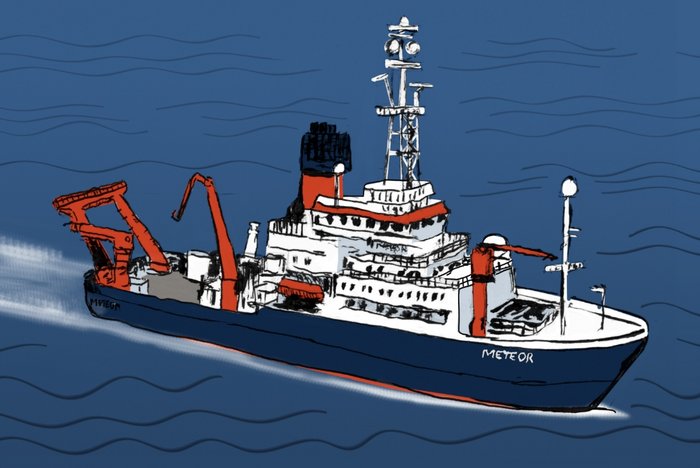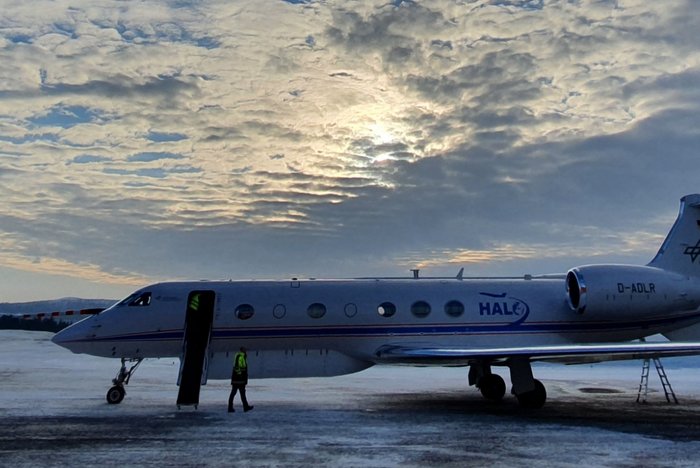ORCESTRA builds on the work of previous campaigns such as NARVAL (2013, 2016) and EUREC4A (2020). In the earlier projects, scientists have investigated how small tropical weather systems, such as cloud clusters, influence large-scale weather movements. This time, the focus is on the drivers and effects of mesoscale convective organization in the tropics.
In the summer of 2024, ORCESTRA will bring together eight independent measurement campaigns, each approaching the question from a different perspective:
How do clouds organize themselves and how does this influence our climate?
Focus on the measurement region
The region of the campaigns is the area of the ITCZ. The Intertropical Convergence Zone (ITCZ) is an important part of the Hadley Circulation, a global air flow system. Air masses rise in the ITCZ, resulting in intense rainfall. This zone is central to the climate because it distributes heat and moisture worldwide and is responsible for about one-third of the world's rainfall. The ITCZ is crucial to the Earth's climate system. As the climate warms, the ITCZ is expected to change. However, climate models have difficulty accurately predicting these changes because of the complexity of the processes in the ITCZ.
Recent findings show that mesoscale processes, i.e. meteorological processes with a horizontal extent of about 5 km to several hundred kilometers, such as thunderclouds and squalls, also determine the overall picture of the ITCZ. This means that the effects of individual clouds must also be considered in order to correctly represent the large-scale circulation in the tropics. To better understand such mesoscale processes, they must be studied in more detail, for which climatologists need models with higher resolution. This requires descriptions of the ITCZ that cover the area from the tropopause to the upper ocean, i.e. from a depth of up to 1.5 kilometers in the ocean to a height of 15 kilometers. During the ORCESTRA campaign, three research aircraft, one research vessel and two observation stations, one in Cape Verde and one in Barbados, will provide the data.
The objective of ORCESTRA is to deepen the understanding of the processes in the ITCZ
ORCESTRA allows to continue the work of EUREC4A and to use current technologies to contribute to a better understanding of this central climate-relevant region and its future changes. In addition, ORCESTRA collects reference points for the calibration and validation of satellite remote sensing by EarthCARE.
Another positive effect of the measurement campaigns is the improvement of climate models, as they summarize and extend our understanding of meteorological processes. ORCESTRA collects data for a new generation of high-resolution, storm-resolving climate models.
BOW-TIE is one of eight independent measurement campaigns carried out under the umbrella of ORCESTRA.
Infrastructure: Research Vessel METEOR
Region: Tropical Atlantic
Campaign period: August and September 2024, continuous measurements during weather events
Scientific director: Dr. Daniel Klocke, Max Planck Institute for Meteorology
Coordination: Yuting Wu, Max Planck Institute for Meteorology
BOW-TIE
The trade winds of the northern and southern hemispheres meet in the Intertropical Convergence Zone (ITCZ). This zone is known for heavy rainfall and high cloud formation caused by this convergence. However, recent research shows that this cloud formation is not only a consequence of the ITCZ, but also actively influences it. The BOW-TIE campaign will investigate how thunderstorms and their interactions with the ocean modify the ITCZ in the Atlantic.
The BOW-TIE project was originally born out of a request for ship time in the year 2019 - but then the pandemic hit. The postponement finally made it possible to combine a series of campaigns in space and time under the umbrella of ORCESTRA. The name of this measurement campaign was derived from the originally planned route of the research vessel, which was reminiscent of a bow tie. To understand the effects of convective storms on the properties of the ITCZ, the ship will cross and measure the ITCZ several times. The current route will allow cross sections of the ITCZ (including the upper ocean) with the surrounding meteorological conditions to be linked to long-term buoy observations from the PIRATA network. The PIRATA network (Prediction and Research Moored Array in the Atlantic) is a system of moored observation buoys in the tropical Atlantic that have been collecting meteorological and oceanographic data to improve weather forecasting and climate research since 1997.
The BOW-TIE measurements provide comparative data for climate models that can accurately represent storm-sized phenomena. This makes it easier to understand why these models can more accurately represent tropical weather systems.
PERCUSION
PERCUSION is a German initiative that uses the German research aircraft HALO and ESA's EarthCARE satellite to study how tropical cloud patterns form over the ocean and how these clouds influence weather in larger regions.
PERCUSION builds on previous research projects such as NARVAL and EUREC4A by investigating additional weather phenomena and air particles over the tropical oceans. It extends the understanding of how clouds and air currents interact in these areas, especially near the Intertropical Convergence Zone (ITCZ).
This campaign will complement the previous EUREC4A measurements, which focused on the winter trade winds, and provide a more comprehensive picture of the tropical weather circulation. The effects of various air particles (aerosols) will also be analysed. The HALO research aircraft will fly for three weeks over the western tropical Atlantic from Barbados and for three weeks over the eastern Atlantic from Cape Verde. During these flights, clouds and air currents will be studied in different air masses: In the west, in relatively particle-free air or in old dust layers, and in the east, in air masses with high Saharan dust pollution.
The studies help verify and improve measurements from the EarthCARE satellite. EarthCARE observes clouds around the world. Data from HALO are used to ensure that EarthCARE data are accurate and reliable, allowing local studies to be extended to a global scale.
PERCUSION is one of eight independent measurement campaigns carried out under the umbrella of ORCESTRA.
Infrastructure: HALO research aircraft
Region: Tropical Atlantic
Campaign period: August and September 2024, selective measurements, targeted approach of specific phenomena
Scientific director: Dr. Julia Windmiller, Max Planck Institute for Meteorology
Coordination: Yuting Wu, Max Planck Institute for Meteorology







